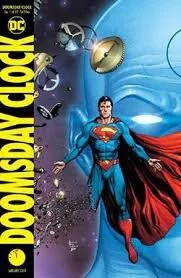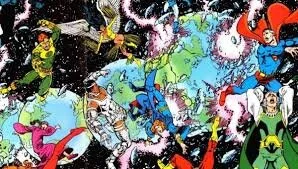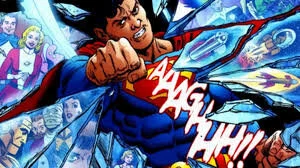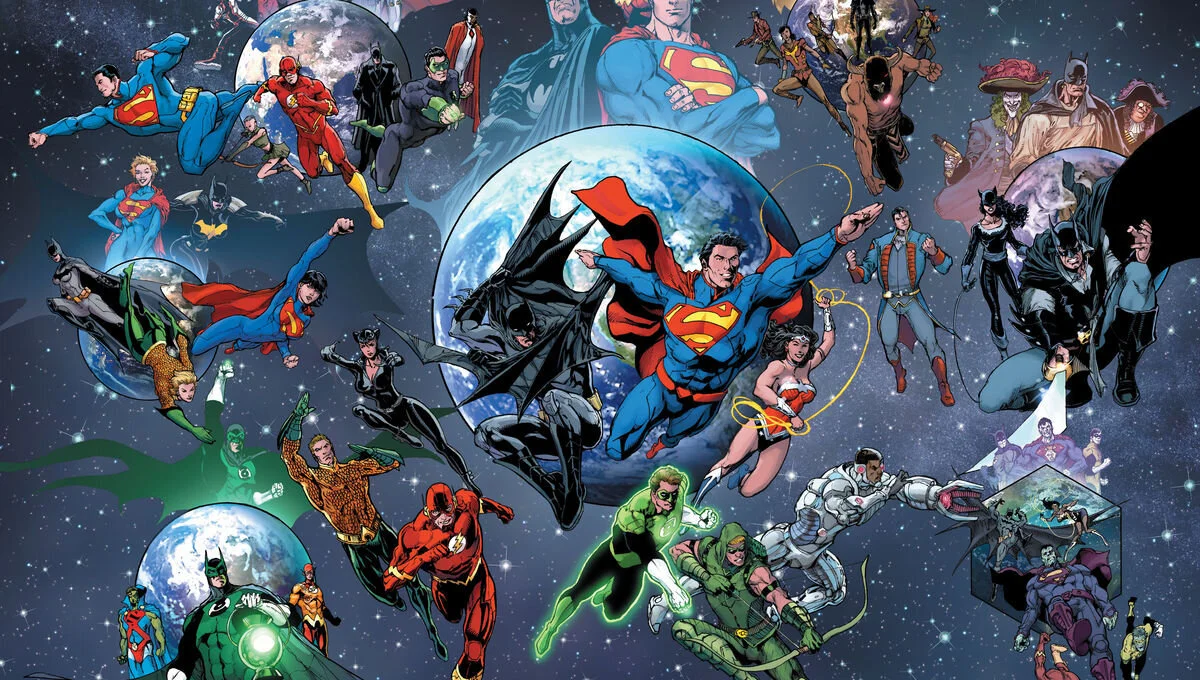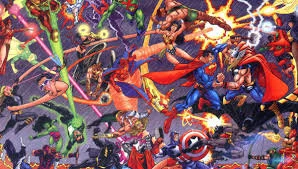McWatchmen: Doomsday Clock
Doomsday Clock, the twelve-issue limited series by Geoff Johns and Gary Frank, seems dedicated to one proposition: convincing the reader that Watchmen was never all that special to begin with. For generations of readers, Watchmen has been the masterpiece co-created by Alan Moore and Dave Gibbons. But the new seres’ very initials (DC!) remind us of what we are really supposed to think about Watchmen. Doomsday Clock is the aesthetic translation of the legal position taken by its corporate owners: Watchmen is a product of DC Comics.
SUPERMAN MEETS DR. MANHATTAN! WHAT AN INCREDIBLE CRAPPY IDEA!
Rather than combat the common criticism of corporate comics by such independent-minded creators as Moore, the strategy behind Doomsday Clock seems to be to take Watchmen down a peg by thoroughly embedding it into the cosmology of the DC Universe. At its worst, Before Watchmen was simply bad or superfluous, but Doomsday Clock tries to drag Watchmen down with it.
My objections to Doomsday Clock can be broken down into three categories:
Ethics. We’ve already dealt with that one.
Aesthetics. This can be addressed rather quickly.
DC editorial politics as a cosmology. This will be the topic for the bulk of the post.
Aesthetically, Doomsday Clock falls somewhere between Before Watchmen and the Morrison and Gillen reinterpretations. Not in terms of aesthetic success, but of approach. By extending and rewriting the story of some of Watchmen’s main characters, Johns’s project is inherently revisionist, but, unlike Morrison and Gillen, his struggle with Moore’s influence does not lead him to experiment with artistic innovation. In Doomsday Clock, Johns’ meets the challenge of Watchmen in an entirely retrograde fashion, aping the wording and pacing of Watchmen in a manner that does him no favors, while treating the book’s content as the site of revision and possible innovation.
When Johns’ borrows one of the most famous verbal structures of Watchmen, Dr. Manhattan’s signaling of the shifts in time in the first Mars chapter (“It’s October1985. I’m on Mars. It’s July 1959 .I’m in New Jersey, at the Pallisades Amusement Park. ), all he does is invite unflattering comparisons. At best he proves he can write a Watchmen pastiche. Morrison and Gillen realized that we do not need more Watchmen when we already have Moore’s Watchmen. Instead, they entered into an artistic dialogue with their predecessor that was enabled by stepping outside of Watchmen’s world. In imitating Watchmen, they did not copy the object; they copied the instructions.
GEOFF JOHNS IS NOT AFRAID OF INVITING COMPARISONS. HE SHOULD BE.
Johns simply writes a sequel to Watchmen. Setting aside the connection to the DC Universe, what we get in the world of the original story is an answer to a question that never needed a solution. It turns out that Rorschach’s diaries were revealed to the public exposing Veidt’s deception. The newly-invented son of Rorshach’s psychiatrist was driven mad by the attack on New York City, and is now the new Rorschach (he’s not just black and white, he’s Black!). And their world is once again on the brink of war.
It is fitting that Johns’ most successful contribution to the Watchmen world is one that is entirely his own creation: the villains Mime and Marionette. When Mime posts his finger in imitation of a gun, he can actually kill someone. They are a pair of engaging sociopaths, a novel twist on the Joker/Harley Quinn dynamic that DC comics had long since exhausted. But here’s the thing: they don’t need Watchmen to exist. Johns could have introduced them into the DC Universe at any point, and they would have fit in without causing a ripple. Indeed, they don’t really cause a ripple in the Watchmen world, which is also part of the problem. They, like the entire series, are superfluous.
I LOVE YOU GUYS! NOW GET THE HELL OUT OF WATCHMEN
Doomsday Clock actually spends very little time in the world of Watchmen; after the first issue, it seems that Johns, like hs protagonists, can’t wait to leave this particular sinking ship. Or perhaps “pirate ship” would be a better metaphor, since the entire project is assembled on the ruins of Watchmen, like the raft constructed of corpses in Tales of the Black Freighter. Since DC owns Watchmen, Doomsday Clock is not, technically, piracy, but technicalities are of little comfort when your ship is being taken from you just because you didn’t get a lawyer to go over the fine print.
Leaving the Watchmen world behind is smart, because it lessens the time spent rewriting a scenario that doesn’t need it. But its also gives Johns more time to play with the series high concept: DC vs. Watchmen. And that is where his pirates walk the plank.
Crisis of Infinite Editors
Doomsday Clock doesn’t just embed Watchmen within the DC universe; it implicates Dr. Manhattan in one of the company’s central narrative preoccupations: revising its own continuity. And this, I’m afraid, is a long story.
As the oldest comics company still in the business, DC has a complicated relationship with its own past. When Marvel revamped the superhero in the 1960, Stan Lee and his collaborators felt free to take as much or as little as they chose from the company’s predecessor, Timely Comics. Eventually, more and more of the Timely material got woven not the Marvel Universe, but that did not change the fact that Marvel ended up feeling decades younger than DC.
When DC did lts own superhero revamp (whose beginnings precede Marvel by a few years), the writers and editors ended up developing a fascinating cosmology in which the World War II comics took place on “Earth 2” and the current heroes lived on “Earth 1.” This was a clever strategy, since it allowed DC to own its history without being bogged down by it. In addition to facilitating the creation of numerous alternate worlds to host a wider variation of plots and outcomes, the multiple earth model also provided a perfect home for DC's strategic acquisitions: every time they bought a distressed comic company’s IP, the newly-purchased superheroes got their own Earth (Earth X for the Quality Heroes, Earth S for the Shazam and the other Fawcett characters, and Earth 4 for the Charlton heroes who inspired Watchmen).
ACTUALLY NOT ALL THAT CONFUSING
In the early 1980s, the corporate consensus was that the DC multiverse was simply too confusing. It’s an odd conclusion, given that Marvel was having great success with alternate futures and parallel earths, both of which were concepts that had been creeping into the mainstream consciousness at the very least since Star Trek introduced its Mirror Universe with its goatee-sporting Spock and evil imperial counterpart to the Federation. The real problem for DC was not complexity per se, but the simplicity that characterized each aspect of its complex cosmology. With few exceptions, such as The New Teen Titans, created by Marvel veterans Marv Wolfman and George Perez to be a Marvel-style book for DC, the storytelling and characterization of DC Comics was looking more old-fashioned by the moment. Cleaning up the multiverse would be the perfect excuse to revamp the characters and bring DC squarely into the 1980s.
ENDANGERED WORLDS AND EMOTIONALLY TORTURED FACES: THE WINNING FORMULA
Crisis of Infinite Earths and most of its follow-ups were, not, technically, metafiction. None of the characters knew they were in a comic book, and no effort was spared in order to make the apocalyptic stakes seem real. And yet there was an undeniable homology between the plots and the editorial mission. The editors' goals, to reorganize, reboot, and revitalize one or more lines of comics, translated the possible cancellation of a given comic book into the death of a character or the destruction of an entire world. In Crisis, a villain called the Anti-Monitor is annihilating one alternate earth after another, while the heroes, brought together by the noble Monitor, manage to save five remaining earths by combining them into one. The result is a new, streamlined continuity that laid the groundwork for significant overhauls of such DC icons as Superman, Wonder Woman, and The Flash.
The godlike Monitor and Anti-Monitor are not just plot functions, but editorial functions. They embody two editorial mandates that look antithetical, but actually work in tandem. They provide the motivation for shuffling the various heroes back and forth across the playing field, mercilessly disposing of superfluous characters, and establishing a new status quo. Both characters are gone by the time the series is over (though each naturally returns in new forms over the next several decades), but, even though the reboot they facilitated was supposed to be a one-off solution to a decades-long problem, the characters, the editors behind them, and the very enterprise of revising continuity became caught up in the endlessly iterative nature of corporate comics. If it worked once (and made money once), why not try it again?
NEVER INVITE THE MONITOR TO YOUR COCKTAIL PARTY
Though perhaps that is slightly too cynical an assessment. Crisis on Infinite Earths was an unfinished project, in that DC rejected the original proposal to restart the entire DC Universe from scratch upon the series conclusion. This led to numerous contradictions within the new continuity, contradictions that would inevitably need solutions of their own. Though even that is not a sufficient explanation for the next three decades of Crisis-like events. The broader explanation brings us back to the metafictional aspects of Crisis. After Crisis on Infinite Earths, DC (its editors, writers, and fans) will be unable to resist the lure of continuity revision, because Crisis made DC continuity as compelling as many of the DC characters, if not more so. Rebooting DC becomes part of the DC brand, and the results of the reboot are at least as compelling a source of suspense as simply wondering how the bad guy will be defeated.
In 1994, DC published a miniseries called Zero Hour: Crisis in Time, whose purpose was to revamp the continuity for a few selected franchises while performing minor tinkering with others (The Legion of Superheroes and Hawkman were hit hardest). Once again, the villains were stand-ins for editors run amok: Extant, whose very name suggests a preoccupation with preservation, and Parallax, the corrupted former Green Lantern Hal Jordan, who was obsessed with re-starting the universe in order to “make things right.” Eleven years later, Geoff Johns orchestrated Infinite Crisis, whose villains were once again obsessed with setting the universe right. This time, one of the villains (Alexander Luthor, formerly of Earth 3) served the runaway editor function, while his unstable dupe Superboy Prime brought to the revision process the passions of an immature fanboy.
SUPERBOY PRIME RESETS CONTINUITY BY PUNCHING REALITY. I AM NOT MAKING THIS UP
Four years later, Grant Morrison’s Final Crisis involved the recreated multiverse, but its biggest surprise was that it spent more time explaining the DC Universe than it did revising it. In 2011, Geoff Johns once again rearranged the DC Universe in Flashpoint, but this time he committed a cardinal sin: the complete transformation of DC continuity had virtually nothing to do with the main plot (a typical superhero alternate reality adventure). Instead, a mysterious purple-garbed woman served as editor ex machina in the final pages, declaring that the universe was flawed, and must be healed through a merger of the main DC Universe, DC’s adult Vertigo imprint, and the Wildstorm Universe that DC had purchased over a decade ago. This woman (subsequently revealed to be Pandora—yes, that Pandora) was far from the power-mad editor/villains of old; she was an absentee editor who stepped in at the last minute to fix a long-standing mess that she had only just noticed.
WHEN INFODUMPS GO BAD
The result was the New 52, initially a commercial success, but eventually a sales and critical disappointment. Not to mention that it brought DC continuity to a new low point of chaotic inconsistency. After yet another set of year-long biweekly series serving as a lead-in (The New 52: Future’s End and Earth 2: World’s End), DC paused most of its publications to run a two-month-long event in 2015 called “Convergence,” in which Brainiac and his “son” Tellos have captured cities from virtually all the previously published iterations of the DC Universe in order to have them fight each other. It ends with a completely incomprehensible continuity revision, seeming to suggest that Crisis on Infinite Earths ended differently.
OK, SURE, NOW IT ALL MAKES SENSE
A year later, after the longest-running New 52 series published their 52nd issue, DC reordered its line once more in a special issue called “Rebirth.” Now the biggest complication of the New 52 revamp (the compression of the heroes’ timeline to just a few years) becomes a plot point: what happened to the missing year? Pandora, the apparent instigator of the New 52, is killed by a mysterious, unseen figure in a manner that visually echoes the death of Rorschach. Over the next two years, the older continuity starts to reassert itself, albeit in a piecemeal, lurching fashion.
OK, THIS, I APPROVE OF: PANDORA IS ONE OF THE FEW IDEAS THAT’S ACTUALLY WORSE THAN HAVING DR. MANHATTAN MEET SUPERMAN
Who is responsible for “Rebirth”? Sadly, it is Dr. Manhattan. Not only did Dr. Manhattan reset DC’s timeline, steal years out of its history, and make everyone forget the Justice Society of America, he even rescued Superman’s Kryptonian father Jor-El from his planet’s destruction. It’s a good thing his four-dimensional perspective gives him a leg up no multitasking, or he’d have had to hire a huge team of interns and assistant editors to accomplish so much mischief.
Setting aside any and all aesthetic criticisms of Doomsday Watch, it is this particularly deployment of Dr. Manhattan that is the greatest outrage. And not because of what it does or doesn’t do to the character, but because of how unnecessary it was to accomplish DC’s continuity goals, and how far it advances a corporate project of denying and independence and autonomy to the Watchmen world.
The easiest way to bring Watchmen into a DC story would have been the tried-and-true formula that inaugurated the entire rhetoric of crisis: following the example of the numerous Justice League/Justice Society crossovers that were almost always entitled “Crisis on [fill in the name of the particular Earth). This has worked for inter-company crossovers (with Wildstorm, back before it was purchased by DC, and with Marvel, in DC vs. Marvel and JLA vs. The Avengers). We could have had a story where Dr. Manhattan meets Superman, Nite Owl meets Batman, hijinks ensue, and everyone goes back to their separate corners.
NO CHARACTERS WERE HARMED IN THIS INTER-COMPANY CROSSOVER
Granted, this would be unimaginative, but so were most of the contributions to Before Watchmen. Shoehorning Watchmen into the DC Multiverse is a more exciting selling point, but the extent to which this has been accomplished is excessive. Blaming all of DC’s confused continuity on Dr. Manhattan is not simply a matter of expediency, or a sales gimmick. It is a renegotiation of the questions of authorship and originality that haunt Watchmen.
It is also a very personal salvo launched by Geoff Johns.
Alan Moore’s Exquisite Corpse
For over a decade, Geoff Johns has been the primary architect of the DC Universe. The author of both Infinite Crisis and Flashpoint, he is a past master at molding convoluted continuity into compelling story. After helping turn Justice Society of America, a sentimental fan favorite with intermittent, limited commercial success, into a critical darling and sales hit, he showed himself to be the one man who could rescue the heroes most ruined by the vagaries of DC editorial.
First, he revived Hawkman, a hero whose Golden and Silver Age incarnations had been thoroughly muddled after an inspired early 1990s revival led to a series of major retcons, each more improbably than the last. Was Hakwman the reincarnation of an Egyptian prince? An alien cop working on earth? A human/hawk Native American hybrid? The avatar of the Hawk God? There is no finer demonstration of a comic geek’s mastery of lore than a long discourse on the history of Hawkman (nor is there clearer evidence that said geek is probably unable to read a room). Johns came up with an elegant solution that somehow acknowledged nearly all of this history while not just rendering it comprehensible, but making room for a wider range of plots in which to insert different versions of the character.
I WILL ALWAYS BE GRATEFUL TO GEOFF JOHNS FOR FIXING THIS GODAWFUL MESS
Johns worked a similar miracle on Hal Jordan, the primary Green Lantern for thirty years before an ill-advised, editorially-mandated storyline made him take a heel turn. Not only did Johns manage to bring back the essential features of the character while shaking off years of continuity barnacles, he also began a years-long odyssey that turned the Green Lantern characters into DC’s best franchise. And this is where Alan Moore comes in.
Moore has complained repeatedly that DC is so starved for ideas that it resorts to turning minor concepts Moore casually developed during his journeyman DC years into the basis for entire storylines. Green Lantern is the case in point:
I was noticing that DC seems to have based one of its latest crossovers in Green Lantern based on a couple of eight-page stories that I did 25 or 30 years ago. I would have thought that would seem kind of desperate and humiliating, When I have said in interviews that it doesn’t look like the American comic book industry has had an idea of its own in the past 20 or 30 years, I was just being mean. I didn’t expect the companies concerned to more or less say, “Yeah, he’s right. Let’s see if we can find another one of his stories from 30 years ago to turn into some spectacular saga.”
As Tim Callahan points out, Alan Moore wrote a total of three “Tales of the Green Lantern Corps,” coming to a grand total of 24 pages. Yet several years of Geoff Johns’s Green Lantern comics trace their roots to these slim tales: the “blackest night,” Sodam Yot, Mogo , the prophecy of Abin Sur. Moore accuses the industry of “going through [his] trashcan like raccoons” in order to produce more grist for their dark, satanic mills, and he’s not exactly wrong. To give Johns his due, rifling through decades of continuity in order to produce the best contemporary stories possible is kind of his thing. But it’s no surprise this puts him on a collision course with Moore: Moore’s M.O., going back to Marvelman, is to reveal that everything you thought you knew was wrong; Johns, by contrast, wants to reassure the reader that all the contradictory lore you have mastered actually makes sense, and is going in a positive direction.
MOORE AND GIBBONS SET THE STAGE FOR A MUCH MORE INTERESTING GREEN LANTERN CORPS. BASICALLY BY ACCIDENT.
Moore and Johns are archetypical comics creators, the Monitor and Anti-Monitor of their profession. Both of them write for the present with a profound awareness of the past, but where Moore is playful, Johns is painfully earnest. Both pros, they nonetheless correspond to a now-classic dichotomy characterizing fans: Johns’ is the professional version of the affirmational fan, preoccupied with the rules and consistency of the fictional world to which he has dedicate himself, while Moore is transformational, more concerned with twisting lore to his own purposes than with consistency for its own sake.
By writing Doomsday Clock, Johns tarnishes his own talent in the service of a manifesto that is both legal and aesthetic. Doomsday Clock insists on treating Watchmen with the same clever and obsessive care that Johns brought to the subpar Green Lantern of the 1990s or the hopelessly convoluted Hawkman from the same period: Watchmen is a set of texts that must somehow be reconciled with the DC Universe. It doesn’t matter that Watchmen had not been connected to the DCU; for Johns, legal ownership renders the text more than merely available: now Watchmen is an essential and inevitable building block of DC continuity. Moore mocks Johns and his colleagues for eating the scraps from his creative table? Fine, now Johns will show him what he can do when he takes the entire feast.
Cause, Meet Effect
The only thing that could be called appropriate about Johns’ take on Watchmen is the same thing that makes it so wrong. Watchmen, after all, by highlighting the unique perspective being “unstuck in time” grants Dr. Manhattan’s, implicitly challenges the very notion of causality. Yes, Jon would never have become superhuman if not for his accident, but non-sequential time renders cause and effect moot.
Moore has repeatedly expressed his regret that creators following his wake have learned the wrong lessons from Watchmen, focusing on the book’s grim darkness as the transcendental signifier connoting “seriousness” and “adulthood.” Watchmen, along with The Dark Knight Returns, inspired decades of graphic violence, mutilation, rape, and torture in mainstream superhero comics without necessarily inspiring good storytelling.
It is true that Moore, in addition to co-creating Watchmen, also wrote The Killing Joke, which featured former Batgirl Barbara Gordon shot in the spine and paralyzed (in a highly sexualized scene). But he is not the one who made DC go dark, or set it off on the dozens of false starts it has suffered through in the past three decades. Watchmen did not ruin the DC Universe, because Watchmen had nothing to do with the DC Universe.
Johns has changed all that. He inherited a situation in which Watchmen stood accused of metaphorically mucking with the DC Universe without actually touching any of its characters. In Doomsday Clock, he renders the metaphor literal. Why is the DC timeline so incoherent? Blame Dr. Manhattan. What happened to the entire Golden Age of DC comics? Dr. Manhattan strikes again.
COMING UP NEXT: DR. MANHATTAN IS TO BLAME FOR POST MALONE
As the jewel in DC’s crown, Watchmen shone too brightly, and its distance from the rest of the company’s intellectual property was an offense. How dare it sit there, untouched for so many years? When all the rest of DC’s IP has been repeatedly dragooned into rebranding efforts, why isn't Watchmen pulling its weight? If the entire economic base of DC comics weren’t corporate capitalism, I would be tempted to see the assault on Watchmen as a kind of populist leveling,
Drawn into yet another crossover event and transformed into the new cornerstone of DC continuity, Watchmen has finally been completely assimilated. As the Borg always said on Star Trek, resistance is futile. There is no superpower that can defeat hegemonic mediocrity.
Eliot Borenstein 6 months ago · 0 Likes
Anders, thank you for all your excellent comments! I appreciate the thought you've put into them, not to mention the links. And Peter David does deserve a lot more credit than he gets!
Johns is a fascinating case, really. He's a really good comics writer (or at least he was), and he combines a Thomas/Gruenwald level of geek knowledge with an unprecedented ingenuity for making things work. But I suspect he really wants to be up there in the comics pantheon with Moore, Gaiman, and Morrison, but the more of their work he touches, the more he shows that he's just not in their league.
Plus, ugh, Flashpoint and the New 52...
Anders Davenport 6 months ago · 0 Likes
“Setting aside any and all aesthetic criticisms of Doomsday Watch, it is this particularly deployment of Dr. Manhattan that is the greatest outrage. And not because of what it does or doesn’t do to the character, but because of how unnecessary it was to accomplish DC’s continuity goals, and how far it advances a corporate project of denying and independence and autonomy to the Watchmen world.”
I completely agree. Overall yours is a very good analysis of why Doomsday Clock ultimately falls flat. DC’s editorial goals (make sure Saturn Girl comes back at some point!) led to an overcrowded story that didn’t really come together in the end. There was far too much going on just to lead up to Manhattan basically waiving his hand and all-powerfully putting things as they “should be,” followed by a bunch of exposition.
I hadn’t realized that Johns had played in Moore’s sandbox so much with his Green Lantern stuff (I didn’t read that run), but, based on what I have read of his (Flash, Infinite Crisis, Doomsday Clock), I think you’re correct in saying that he “wants to reassure the reader that all the contradictory lore you have mastered actually makes sense, and is going in a positive direction.”
Johns isn’t a bad writer, but he hasn’t done his legacy any favors by writing a sequel to Watchmen. Doing so has only highlighted his limitations, which is unfortunate for him as Doomsday Clock will likely be the biggest project of his career.
John C 9 months ago · 0 Likes
Not to defend Doomsday Clock....I’ve read most of it, and it is uneven at best....but to deny the impact Watchmen has had on DC (and superhero comics in general) seems odd. I know it had nothing to do with DC continuity, but as a work of art, it impacted the entire medium.
In that sense, Johns’s decision to tell this story seemed to at least have something to say in a meta way.
However, whatever that idea might have to offer seems to be lost in the attempt to use the story to tweak DC continuity yet again.
Great analysis though. I’m enjoying your essays.
Eliot Borenstein 9 months ago · 0 Likes
Thanks, John! I take your point. I did not intend to imply that Watchmen didn't have an influence on DC--it did, just not the influence its creators would have wanted. Of course, no creator can control how the work is received.
There are plenty of good ways to respond to the darkening of superhero comics after Watchmen and TDKR, but, as with almost all the really provocative artistic reactions to Watchmen, they're less direct. Astro City, for instance, is an extended rebuke of "grim and gritty."
It's when the writers insist on being so literal (staying in the fictional terrain of Watchmen) that they end up coming off as unimaginative by comparison.
The last issue hasn't come out yet, but I can't help but wonder if the main question asked by Doomsday Clock is that of the stereotypical 8-year-old fan: If Dr. Manhattan and Superman got into a fight, who would win?
